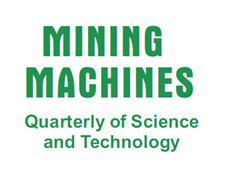Coal quality monitoring and control during its beneficiation
S. CIERPISZ
Possibilities of increasing an efficiency of control coal beneficiation process in pulsating jigs of KOMAG type
D. KOWOL, M. LENARTOWICZ, M. OSOBA,
New generation of pulsating jigs of the KOMAG type for gravel and sand winning
M. OSOBA, A, LUTYŃSKI
DISA 3/2KR-2600/2000 two-functional suspension separator as the device for direct three-product or two-product beneficiation
S. SOREK
Dynamic impact of super resonance screens on the supporting construction
T. BANASZEWSKI, A. FILIPOWICZ
Identification of dynamic load of vibrating feeder for the FEM strength analysis
T. WINKLER, M. OSOBA, S. BOJARA, W. CHUCHNOWSKI, J. TOKARCZYK
Vibrating screen – continuous process of searching for optimal solutions
Z. ŚMIEJEK
Municipal wastes segregation by dry methods
P. WODZIŃSKI
Procedures with wastes generated in processing plants in the light of the environmental protection requirements
D. KASPRZAK, B. GRYNKIEWICZ-BYLINA
Product safety and responsible for the product in European legal system
Romana ZAJĄC,
Coal quality monitoring and control during its beneficiation
S. CIERPISZ
S u m m a r y
Use of instrumental methods of measurements of ash and water content as well as coal caloric value in systems for monitoring and control the quality parameters of coal products was presented. Examples of systems for stabilization of ash content and maximization of coal production were given. Systems of single jigs as well as simple and complex technological systems were discussed. Special attention was paid for optimization of production of steam coal mixtures using an automatic quality control system.
Possibilities of increasing an efficiency of control coal beneficiation process in pulsating jigs of KOMAG type
D. KOWOL, M. LENARTOWICZ, M. OSOBA,
S u m m a r y
Selected R & D projects, realized in Processing Systems Division at the KOMAG Centre, on an efficiency of raw coal beneficiation processes in pulsating jigs of the KOMAG type, were discussed. Test results of influence of measurement float shape of the separation layer on beneficiation products offtake stabilization and intensification of heavy product offtake through the channel slits using impeding baffles, were presented.
New generation of pulsating jigs of the KOMAG type for gravel and sand winning
M. OSOBA, A, LUTYŃSKI
S u m m a r y
Many years of KOMAG experience in jigs designing and selection, enable to use them in aggregate industry, especially for gravel and sand winning with the separation of organic impurities. Technological studies of gravel and sand separation, conducted in laboratory conditions on a test stand and industrial studies carried out in selected mines which use technological systems based on beneficiation of raw coal in pulsating washery jigs, confirmed a purposefulness of use the designs proved in hard coal processing for gravel and sand production. The new generation of a jig of the KOMAG type (pulsating classifier) operating in aggregate mine in industrial condition was presented.
DISA 3/2KR-2600/2000 two-functional suspension separator as the device for direct three-product or two-product beneficiation
S. SOREK
S u m m a r y
The process of modernization and adaptation of jigs design to the requirements associated with Mining Plant modernization aimed at adaptation to new technological requirements was presented. A design description, which enabled to follow the change sequence made till the development of a new jig of significantly extended possibilities due to its modular construction, was presented. An example of installation of the DISA 3/2KR-2600/2000 two-functional suspension separator in the coal processing plant at “Pniówek” Colliery was given.
Dynamic impact of super resonance screens on the supporting construction
T. BANASZEWSKI, A. FILIPOWICZ
S u m m a r y
Dynamic impact of super resonance screens on a direction parallel to the steel, screw-and-cylinder spring was described in details. The amounts of impact can be determined by the commonly used formulae. Lack of simple functions, describing a horizontal impact of the screen, results from not explicit description of transverse rigidity of the springs. A survey of methods used to describe the elasticity factor of cylinder steel springs on a direction perpendicular to their axes was presented in the paper. The simplest empiric formula describing the transverse rigidity basing on the spring longitudinal rigidity had been selected from the suggested methods. That formula was used for calculations of elasticity value on the direction perpendicular to spring axes in ten or so screens. The measurement of transverse spring rigidity was conducted to verify the formula. The measured value differed from calculation results by about 9%.
Identification of dynamic load of vibrating feeder for the FEM strength analysis
T. WINKLER, M. OSOBA, S. BOJARA, W. CHUCHNOWSKI, J. TOKARCZYK
S u m m a r y
The method for dynamic and strength calculations of the WPR 1,3x4,5 vibrating feeder was presented. The correctness of accepted design requirements was the aim of the numeric calculations. The feeder design was modified in a result of conducted analyses.
Vibrating screen – continuous process of searching for optimal solutions
Z. ŚMIEJEK
S u m m a r y
The screen is one of the main technological machine in all installation for minerals processing. Role and tasks of the screen is are decisive for the whole process and often it decides about beneficiation results, that is why so mach attention is paid to its design and operation. That machine undergoes the process of continuous improvement of technical and technological parameters. The design proposal, presented in the article, relates to theoretical grounds and has been compared with the solutions of similar functions used in the Polish mineral processing plants. The screen having a broken deck line, set to vibration move by the single inertial drive, realizes a dry classification process with circle-and-elliptical trajectory, according to the rule of “angles of slide” and with acceleration. of 5g The machine is a very important component of the washery jig installation, which can improve the processing products quality and first of all it enables to reduce operational costs. KOPEX S.A. with a co-operation of other companies plans to carry out the classification process by using this machine in Polish and foreign processing plants.
Municipal wastes segregation by dry methods
P. WODZIŃSKI
S u m m a r y
Wastes segregation is the problem which arises around the world. The selective scrap collection i.e. segregation at place of their generation can only partially solve the problem of their recycling or their re-utilization by known methods. Especially in municipal agglomerations the selective wastes collection can be partially realized. The article describes a development of scraps segregation method at the municipal waste dumps. The work concerns both the technological issues and apparatus problems i.e. design of machines and equipment in which the process is realized. A scrap segregation technological line consists of the autonomous devices that can be arranged in any configuration under umbrella roof or solid ground. All the devices are linked with the special flight-bar feeders, what can enable to direct wastes stream to any machine and equipment (in dependence on the conditions). The suggested technological line, designed for the communal wastes segregation, can be optionally changed by adding or removing its components or even by adding new technological operations. Addition or removal of machines and equipment can result from user’s requirements, which would want to segregate the wastes more precisely. The author is conscious that his proposal will not replace the selective waste collection but can be its completion. The article tries to present each of the process phase in municipal wastes segregation.
Procedures with wastes generated in processing plants in the light of the environmental protection requirements
D. KASPRZAK, B. GRYNKIEWICZ-BYLINA
S u m m a r y
Most important aspects of management of wastes generated in hard coal processing plants were presented. A survey of recovery and neutralization methods of the above mentioned wastes was made. Some examples of the solutions concerning the waste management and the technologies of reduction of wastes generated in mines, suggested by KOMAG, were given.
Product safety and responsible for the product in European legal system
Romana ZAJĄC,
S u m m a r y
The protection of consumer rights is one of the most important objectives in EU policy. It should be admitted that in case, when the product does not meet the safety standards, legal measures can be undertaken against any person involved in a supply chain. In EU there are still many directives of old approach, which do not allow to receive the CE mark, so new horizontal directives, which regulate the main safety aspects, have been developed. Also the fact that a new global approach gives slightly different definition of manufacturer than the directive on responsibility for damages made by defective product is important.
KOMAG Institute of Mining Technology
MISSION
Innovative solutions for economy.
VISION
Research and development centre of organizational and proprietary structure adapted to the market activity in the European Research Area and of the organizational culture creating a friendly climate for generating new ideas and realizing innovative activities, i.e. transforming new ideas into new products.
Read moreDesign
Designing of machines and equipment
Tests
Laboratory of Applied Tests
Certification
Assessment of products' conformity
Projects
Projects realized by the KOMAG Institute from European Funds
© 2025 KOMAG Institute of Mining Technology





 Badanie bezpieczeństwa wyrobów
Badanie bezpieczeństwa wyrobów Klaster Maszyn Górniczych
Klaster Maszyn Górniczych